Keep on Composting
One Problem in Cold Weather
I don’t let cold weather put the brakes on my composting, at least my role in it. For the bacteria, fungi, and other workers in my compost pile, it’s another story. Come cold temperatures, and their work come screeching to a halt or near halt (which depends on the degree of cold, the size of the pile, the mix of ingredients, and moisture).
But that’s no reason for me to abandon composting.
The main problem, as I see it, with composting in winter is not the workers not working. Pile up food scraps another organic materials winter, and composting will re-convene when warm weather arrives again in spring. The problem is that those food scraps offer a smorgasbord of tasty, easy calories for rodents. Which is not good.
(Lest you’re feeling fuzzy and warm to these furry creatures, a short list of what they could bring along to you would include hantavirus, leptospirosis, lymphocytic chorio-meningitis, rat-bite fever, salmonellosis, and tularemia, all of which are as bad as they sound. And that’s only a partial list.)
I take a multi-pronged approach, then, to keeping rodents at bay yet carrying on with my role in composting.
Population Control
My first line of defense is to keep rodent populations in check.
The top layer of the compost pile is not the only place where rodents might find a meal. In autumn, I clean up any rodent treats that might be lying around such as ears of corn, old squash and tomato fruits, and baskets of filberts or black walnuts. As appropriate, they go either onto the compost pile or into animal-proof storage.
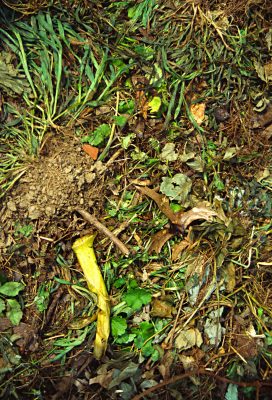
Sammy, Daisy, and Gracie also help out. They are, respectively, a dog and a dog and a spayed cat, who spend most of their time outdoors. (I know, I know about the problem with cats and birds. But I’m trying to strike a balance. A few less birds weighed against soaring rodent populations seems reasonable. And anyway, Darwinian selection may be going on here for birds that are increasingly learning to avoid Gracie. At least, not to get too graphic, judging from the “gifts” Gracie brings back to show off.)

Dogs at “work”
I support the work of Sammy, Daisy, and Gracie by doing some trapping on my own, mostly of rabbits and squirrels because they can damage or kill plants, and pilfer my food. Black rat snakes, which sometimes go so far as to lay their eggs in my compost pile, also help out.
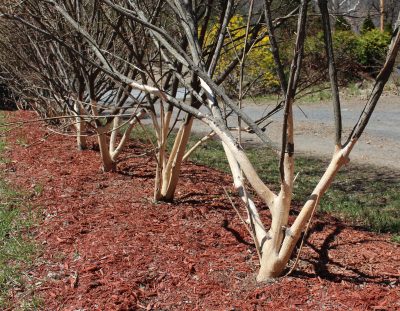
Mouse damage

Rabbit damage to branches
Exclusion
My second line of defense is to keep rodents out of my compost pile. A number of heavy-duty plastic or metal, animal-resistant compost bins are available for sale, and all work pretty well — as they should, since any pile of organic materials will eventually turn to compost. Their usual limitation is that they many lack sufficient volume for a critical mass if you want to make hot compost.
I made my own compost bin, actually bins. Having two or more allows compost to mellow in one bin while the other one or ones are still cooking. My bins are rodent-proofish. They are so, first of all, by my setting them up in flat ground upon which I first lay down a large enough piece of 1/4 inch or 1/2 inch mesh hardware cloth to keep the critters from tunneling up from below.
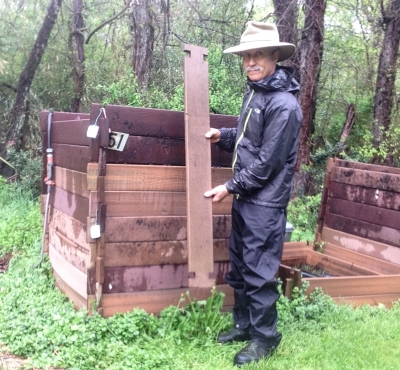
The bin itself is made of notched, fake wood (such as used for decking). As the notched pieces slide together, the tolerances were designed to be close enough to deny rodents access. Ah, but “there’s many a slip ‘twixt the cup and the lip;” my carpentry skills fell a little short of making all those notches small enough, which would be less than 1/2 inch, to allow entry by even a mouse. Still, the bins work pretty well.
I detail the material I used and the construction of the bins at https://leereich.com/2019/06/my-compost-for-a-bin.html.
Scavenger Friends
Rodents are wily creatures, and I expect that they could somehow jump and climb their way up the bins to the top of the pile where the freshest delicacies have been most recently placed. Originally, I planned to make rodent-proof covers to the compost bins, but they never got out of the early planning stage.
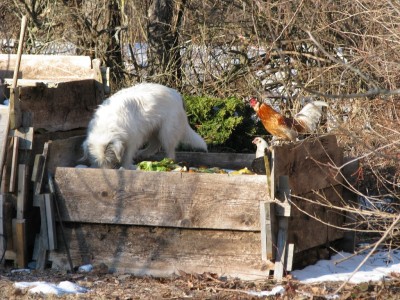
Turns out that my dogs are very good jumpers, and also very fond of kitchen scraps. My ducks are adequate fliers/climbers, and likewise show interest in this department. So the plan here is to deposit compostables from the kitchen onto the compost-pile-in-progress each morning, when ducks and dogs are out and about. They clean up all of the most desirable and calorie-laden stuff, leaving little or nothing for any rodents who, excepting squirrels, are mostly nocturnal.
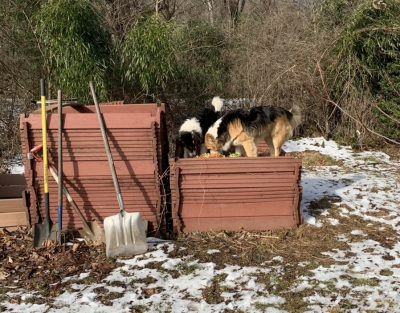
Note: As I re-read what I’ve written I realize that I could be accused of not being pc for a number of details stated. Sorry. But composting itself is very pc, and reality often involves striking balances to get the most desirable results.


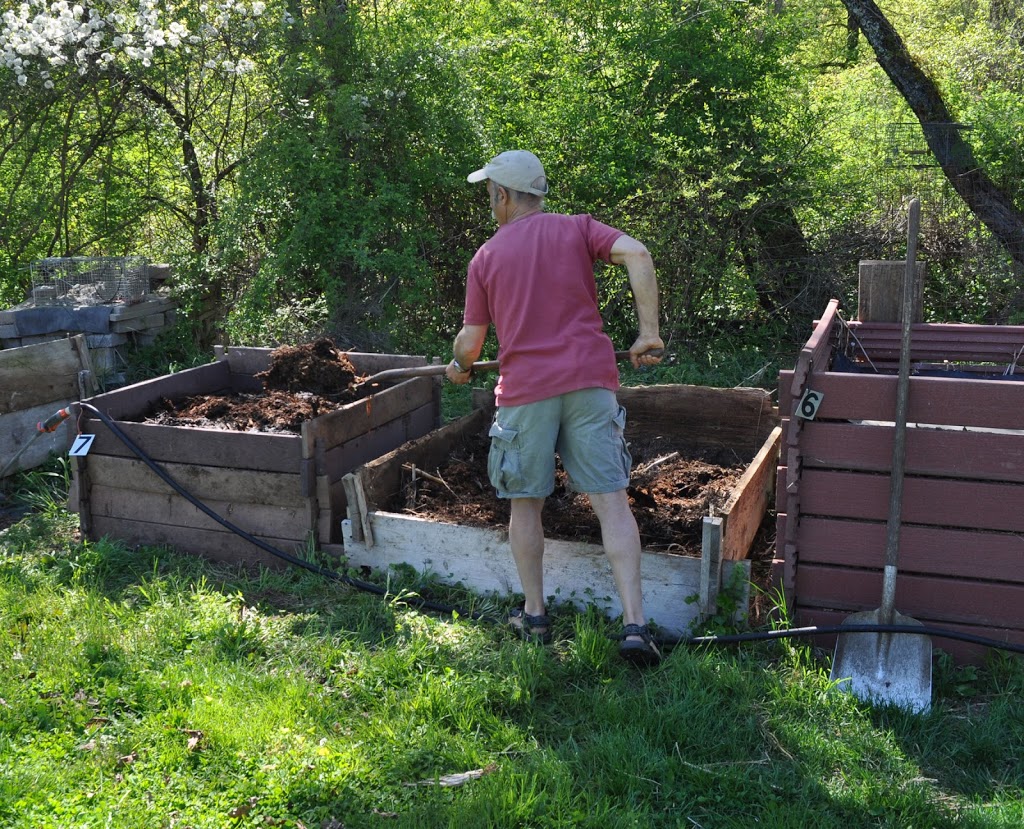

Hi Lee,
I agree with and understand your comments on outdoor cats and the birds. As a veterinarian, I struggle with this one as well – both for the sake of the birds but also the mental well-being of many cats who truly need that time outside. I did just want to caution you about letting your dogs eat from the compost pile though. From your post, it sounds as though they only eat the fresh toss-outs…this may be fine as long as those scraps are fresh (and haven’t sat in a bucket for awhile like mine) and they don’t decide to eat anything on the layer beneath. I’ve seen many dogs come in for compost “toxicity” – bacterial gastroenteritis but also neurological signs due to toxins released by the bacteria. Just wanted to give you a heads up. I always enjoy your posts!
Best,
Nicole van Harreveld
Milton, VT
Thanks for the good information.
Great post, Lee, and living closer to nature removes sentimentality for nature, increases respect and appreciation, and normalizes the need for healthy boundaries. It’s not “PC” to expose oneself and household to disease.
Having said that, my dog’s digestion can’t handle what yours’ can, much as I appreciate the thrift of it, and I’ve found that a hungry mama bear just before or after hibernation can be scary-bold up here in Mt. Tremper, dog or no dog. So the good news is, we can now bring our food scraps to the Woodstock or Kingston to compost.
I use the simple open pile method and use the tractor bucket to turn now and then when it’s not frozen. In the winter, I’ve been mixing the kitchen scraps with the wood stove ash, which goes into the fall leaf compost pile. I’m hoping that this discourages pests from entertaining a meal. Moles and voles seem to be our most numerous pests.
What do you think about mixing food scraps with wood ash for compost pest management?
Just be careful not to use too much wood ash. It’s very alkaline. I heat with wood so generate a lot of ashes, so disperse them all around my farmden.
Hi Lee – How are viruses carried by rodents, spread from/through our compost? Is the virus found in the new compost/soil? Thanks so much for your blog – I enjoy it very much!
In the example of hanta virus, it’s spread by mice and rats as they shed the virus in their urine, droppings, and saliva. Tiny droplets with the virus can enter the air. People can get the disease if they breathe infected air or come into contact with rodents or their urine or droppings. As another example, lymphocytic chorio-meningitis infections can occur after exposure to fresh urine, droppings, saliva, or nesting materials from infected rodents. Transmission may also occur when these materials are directly introduced into broken skin, the nose, the eyes, or the mouth, or presumably, via the bite of an infected rodent. Not all the problems listed are viruses, and means of transmission varies.
I bought a big bag of dried red pepper flakes and sprinkle it on each layer as it’s being built. No more rats.
Good idea. I’ll try it.
Unfortunate to hear your pseudo-scientific justifications for the catastrophic and preventable destruction wrought by outdoor cats. As a person who uses science and has a large audience I believe you have an opportunity to teach good science and perhaps just shy of a major responsibility not to share junk science, selfish disregard for evidence nor horribly destructive choices as perfectly fine. I strongly suggest that you rethink your choices and at least, give your audience actual empirical resources (American bird conservancy) not your opinion that your choice is somehow justified by a fear of hantavirus. Toxoplasmosis is also real and easily prevented from entering wells should people be responsible and keep their non-native pets indoors. In the time of our worst biodiversity crisis yet, I would hope someone of your education ,means, and position would make for more-informed choices or at least choose not to broadcast your science-averse personal choice as somehow reasonable. Using an oversimplified and misunderstood Darwinian concept to further justify adds insult to injury. I’ve been a fan of yours for decades and I’m seriously disappointed. Please reconsider your choices.
True, I didn’t consult actual numbers in my assumptions. So what do you suggest for those of us who want to keep on composting and don’t want to be overrrun with rodents? Or overrun with rodents even if we don’t compost. They are very fecund and adaptable.
Hot pepper based products. More hardware cloth. Build your cat a protected outdoors bird-safe enclosure and use creative methods to lure rodents in striking distance. Plenty of DVMs disagree that cats are better off freely roaming around their environments (not to mention the bulk of the empiricism-based scientific community) and there are many dangers to the cats that can be avoided by more human accountability, attention and best practices that include caring about your neighbors’ health, the environment, physical safety of your pets and the entirety of the ecological picture. Wash your food and your hands and wear a respirator around feces. Vote for better policies that mitigate environmental disaster. These are my suggestions.
Hi Lee,
When you say you support your pets by trapping, what kind of traps do you use for rats or mice that might effect your pile. I find that I have a solid problem with rats in my six bins. I have used old snap traps and they have worked well, but they are now smarter than them. I used sunflower butter as bait and now they do not go near it.
Also, cover the pile with a rat proof material?
Thanks as always.
A snap trap inside a live trap usually gets a rat.
Do you avoid putting moldy stuff into your bins? Or do you count on the heat generated to kill the spores?
Everything goes into the bins. It all eventually decomposes. Yes, heat can also kill the spores, but they can also be gobbled up by other organisms.
Hello Lee,
My compost pile does not have rodents but I have something just as bad. Red ants!
Any suggestions. Thanks
Are red ants on a compost pile truly a bad thing? If so, try sprinkling cinnamon, which is generally a good ant repellant. (Perhaps also repels rodents?)
Red Imported Fire Ants will not only forage for food (such as small insects, dead animals, and sweet materials such as plant secretions) but will kill insects and small animals to feed .The Southern Fire Ant is attracted to a variety of foods including protein, greases, and sweet foods.
for more: https://exopest.ca/fire-ants-control/